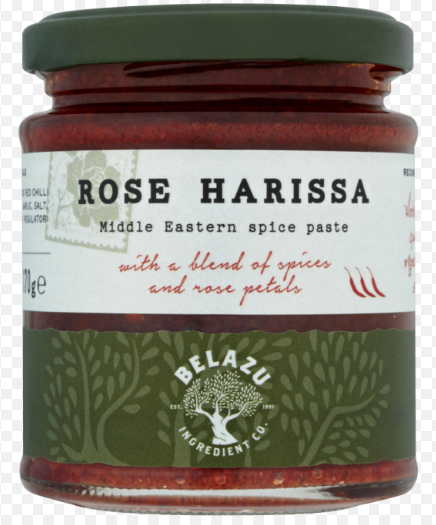Blanche Vaughan's Blog, page 2
January 20, 2016
Morocco: land of milk and honey
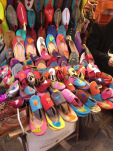

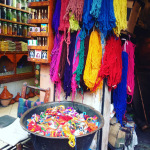
This year I spent Christmas in Marrakech, staying in a traditional riad the heart of the medina – the old city. Our friends and hosts were great cooks and enthusiastic entertainers and the next few days would be a celebration of Morocco’s extraordinary and exotic food.
Outside the thick, clay walls of the riad, a tangle of narrow alleys led onto the main square, Djemaa el Fna, where the hawkers, market stalls and performers tempt, hassle and entertain. At night, rows of street food vendors cook Moroccan delicacies over burning coals, and the air is filled with smoke and the scent of spices.
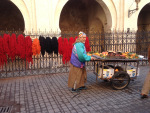
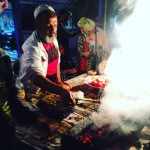
Riads are designed with a central courtyard or internal garden, usually on the ground floor, with rooms over two or three stories, all facing into the central space. Our courtyard was full of lush green palms and orange trees, laden with fruit, surrounding a pool of water. A steep staircase led onto the roof terrace where we ate breakfast, looking out over the tightly packed houses of the medina and the towers of mosques reaching into the sky. In the distance, the Atlas Mountains loomed like huge clouds.

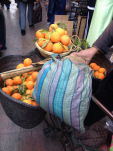
The medina is home to main souk, where tourists flock to haggle over Berber carpets, leather bags, djellabas and Moroccan slippers. Beyond the souk lies the Mellah, (the meat and vegetable market in the old Jewish quarter), where we headed to buy ingredients for Christmas festivities and feasting. Squeezing down the narrow alley leading into the market, lined with cages filled with chickens and tiny chicks, squawking and flapping; we wrapped our scarves over our faces to filter the stench and pushed further in, past huge slabs of beef, bright red and freshly cut.
Beyond the meat section (which even I found challenging), it was a relief to reach the vegetable and grocery stalls. Winter vegetables – turnips, cabbages, cauliflower, potatoes and other roots – were piled high alongside fennel with cascading green stalks, baby aubergines, swathes of herbs, scarlet pomegranates and bright citrus fruit. The displays of La Perle d’Olive immediately caught my eye. A colourful stall selling preserves: confit lemons, pink, green and black olives, bright red harissa of extraordinary fieriness, khlee (confit beef) and a delicious green olive tapenade which we tasted in great spoonfuls. As our bags filled with shopping, inspiration for dinner took its course.
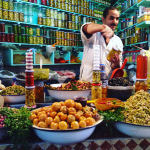

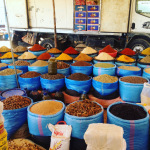
Back in the riad kitchen, we got to work. I marinated the chicken in coriander, cumin and preserved lemons; roasted the potatoes with harissa and braised the carrots with onions and ground coriander seeds. Our hostess made a salad of bulgur wheat, herbs and pomegranate and for pudding I made an almond cake with orange flower water and lemon syrup, which we served with mint tea and pistachio nougat from the souk.
After a few days of celebrations, cooking, eating and shopping in the city, it was time to escape to the coast for New Year. Three hours drive north west of Marrakech is the seaside town of Oualidia. In the summer months the town is full of Moroccans fleeing from the city in search of the cool sea breeze. At this time of year, just the farmers, fishermen and a few stray holidaymakers remain.


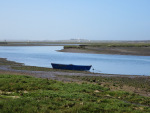
Oualidia is famous for its seafood, surfing and huge saltwater lagoon. The lagoon lies along several miles of coastline, protected from the crashing Atlantic waves by a long stretch of rocky cliffs. Gaps in the rocks allow the seawater to flow into the lagoon, so the water levels rise and fall with the tide.
At low tide, fishermen wade out to gather clams and baskets of oysters, which can be bought by the piece from sellers on the sand, to eat in your fingers, sucking the sea juice from the shells. Men on the beach sell freshly grilled fish, which they’ve cooked on small charcoal barbeques. We bought a sole straight off the fire and ate it standing there, tearing pieces of succulent flesh from the bones with our hands.
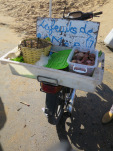
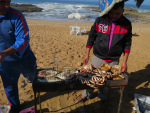
The house where we stayed stood just above the lagoon. Leading down to the water was a large strip of land that had been made into a vegetable garden where beetroots, cauliflowers, courgettes, salads, thrived in the winter sun. At the top of the garden was a hen coup that provided fresh eggs for breakfast, which we ate soft boiled with homemade bread. Honey came from the house’s hives.
Most abundant of all was the fish: we made daily trips to buy sea bass, spider crabs, sole, oysters, lobsters and cuttlefish directly from the fisherman. Cooked simply and accompanied by samphire we picked that grew all along the shoreline.
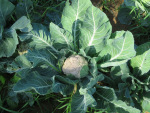
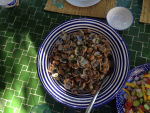
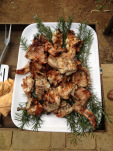
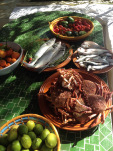
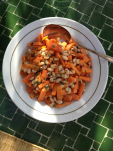
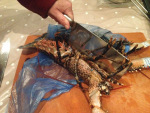
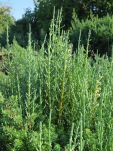

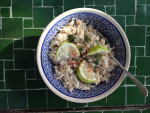
When we weren’t cooking and eating at home, we visited the local market to shop and eat. Some stallholders had barbecues where they grilled skewers of meat over hot coals; others displayed rows of tagine pots, the steam escaping as they lifted the lids to show the contents cooking inside. We bought skewers of spice rubbed chicken, which were stuffed inside soft bread with chopped sweet onion and herbs. One stall had a vat of oil in which they fried doughnut like pastries. We watched as the wet white dough was dexterously shaped into rings and dropped into the boiling fat to swell and turn golden. These we carried home in a paper bag to sprinkle with sugar and cinnamon while they were still hot.
There were wooded carts piled high with clementines, the fruit squeezed to order. I drank a glass of the sweet juice, aromatic with the oils from the sun soaked skin. Others carts were laden with olives, spices, vegetables and nuts. Sellers of bright wools and woven blankets, baskets and metal hardware had laid their goods on blankets on the ground and one meat seller had butchered a whole sheep that he displayed on his wooden slab, every organ and joint neatly laid out.
I stood in the market place, amongst the colours and the smells, the abundance and variation, and I felt the inspiration that only comes from discovering things first hand: the raw ingredients that provide this nation with one of the greatest cuisines.



November 24, 2015
Harira soup with Rose Harissa
These darker, colder days call for warming sustenance and where better to turn than to the fragrant spices of Middle Eastern cooking? Harira is a soup I love to make when the weather turns, a traditional Moroccan dish which uses vegetables, spices, chickpeas and can include lamb for extra nourishment. Everything is cooked slowly to bring out the maximum flavour and if you make a big batch, it will keep for a few days in the fridge so you can warm up a bowlful for a fast and healthy meal.

I add a spoonful of harissa, a North African sauce made with chilli pepper, paprika, cumin and other spices for extra warmth and depth of flavour. I’ve recently been using Belazu’s Rose Harissa which includes dried rose petals. This may sound odd, but it provides the delicate scented experience often found in Moroccan food where fruit, nuts and rose petals are often used in savoury dishes. A jar of harissa never goes to waste in my kitchen: one of my favourite breakfasts is fried eggs with rose harissa, toasted Poilane and a dollop of cooling yoghurt.
Lamb harira with chickpeas
Serves 6
2tbsp olive oil
300g neck lamb fillet, or boneless chops or shoulder
2 large carrots, diced
4 large celery stalks, diced
4 cloves garlic, finely sliced
2 tsp ground turmeric
1 tsp ground cinnamon
2 tsp ground ginger
20g flat leaf parsley, roughly chopped
1 bay leaf
1 tin (400g) tomatoes
1 tbsp Harissa paste
or 1 red chilli, deseeded and finely chopped
400g cooked chickpeas
1.5l cold water
To serve:
½ lemon, juiced
4 large celery stalks, diced
In a large, heavy bottomed pan, heat the oil and brown the lamb well on both sides. Remove to a plate.
Add the carrots and celery and a pinch of salt. Fry for a minute or so to begin to soften then add the chopped garlic, spices and parsley and bay. Stir well and cook together for a couple of minutes – there will be a wonderful aroma of spices and herbs. Add the tomato and harissa and let it simmer for a few minutes before adding the chickpeas. Season generously with salt and pepper and return the browned lamb to the pan. Cover with 1 ½ litres of cold water and bring to a simmer. Cook on a low heat for about 2 ½ to 3 hours, skimming occasionally if any bubbly scum rises to the surface.
After this time, you can turn off the heat and allow the soup to cool completely. This will intensify the flavours and leave the lamb cool enough to handle. Remove the meat from the bone and pull into bite sized pieces and return to the pot.
To serve, heat to a simmer and sprinkle over the lemon juice and chopped coriander.


November 13, 2015
Game terrine

A good terrine can be one of the greatest pleasures of the kitchen, both in the making and the eating. It may take a bit of time to prepare, but it lasts well too; if you don’t eat it all in the first sitting, it is a welcome dish to discover in the fridge; an instant and satisfying lunch. It also makes an impressive and hassle free starter if you’re entertaining.
I love the process of putting all the parts together; it something you can really build, both in terms of structure and flavour.
The spices and herbs in the marinade bring out the best characteristics of the game that is kept succulent by the flavourful forcemeat. I was inspired to make this after a trip to my local farmer’s market, where I saw a bounteous display of Autumn game for sale; although any good butcher would be able to provide the same for you. For the marinade of the game, I used some Spiced English Vermouth from a microdistillery in Gloucestershire. It’s certainly not necessary to track it down, but the idea is you could experiment with different alcohol to compliment the game as you fancy (but red wine always works well).

The game:
6 partridge and/or pigeon breasts
400g venison fillet, cut into 2cm pieces
20g thyme sprigs
1tbsp juniper berries
1tsp blade mace
1tsp black pepper
150ml red wine or spiced English vermouth

The forcemeat:
30g butter
1 onion, finely chopped
2 cloves garlic, finely chopped
300g chicken livers, any sinews or dark parts removed
2tbsp brandy
4tbsp breadcrumbs soaked in warm water or stock
1tsp chopped thyme
2 eggs, beaten
700g pork mince


To line the tin:
Approx 10 slices of streaky bacon
2 bay leaves
For the game:
Put the partridge (and/or pigeon) breasts in a small bowl and a put the venison pieces in another small bowl. Divide the thyme, juniper, mace and pepper equally and add half to each bowl, then pour the wine over each.
Leave to marinate over night, or for up to 24hrs.
For the forcemeat:
In a frying pan, melt most of the butter and gently fry the onion and garlic with a large pinch of salt, for about 5minutes or until the onion begins to soften but not colour. Remove to a large bowl.
Add the rest of the butter to the frying pan, turn up the heat and add the chicken livers. Fry briskly, stirring the livers so they colour all over. Pour in the brandy and let it bubble and reduce. Chop the livers finely and add to the bowl with the onions.
Add the rest of the forcemeat ingredients and plenty of salt and freshly ground black pepper (remember you will be eating this cold so it needs to be highly seasoned). If you’re not sure how to judge this, you can take a teaspoonful of mixture and fry it until cooked then taste it, adjusting as necessary.
Preheat the oven to 180°C.
Find a roasting tray that the terrine mould fits into comfortably, with room around the sides, and lay a tea towel on the base (this will prevent the bottom of the terrine from getting too hot).
Line the terrine mould or cake tin with the bacon slices so they cover the base and sides but hang over the edges.
Remove the breasts and venison pieces onto some kitchen towel and brush off any large pieces of spice.
Put a layer of forcemeat in the terrine mould, followed by two breasts laid in the middle and the venison on either side. Repeat this until all the game is inside, and finish with a layer of forcemeat. Wrap the bacon slices over the top to cover the terrine and place two bay leaves over the bacon to finish (the flavour of the leaves will seep into the terrine as it cooks).
Finally cover tightly in foil.
Place the filled terrine on to the tea towel in the roasting tray and pour hot water (from the kettle) around the sides of the terrine in the tray, so it is ¾ deep in water.
Place carefully in the oven and cook for 2hrs.
Remove the terrine and carefully peel off the foil, the meat will have shrunk slightly and the juices will be clear. Set on a rack to cool completely before turning out and slicing.
Serve with hot buttered toast, cornichons and a green salad.



September 15, 2015
Home grown – courgette soup with white beans
Getting married meant moving into a new house. A house that already belonged to my husband, but was a place in which we needed to create a new home together. This can be challenging, especially when little superficially needs to be changed; it was fully furnished, nothing needed redecorating and even the garden was well established. The kitchen soon became my first place to settle in: I filled the shelves with my cookbooks and I hung my favourite pots over the cooker, but still there was a rootedness which I lacked. It was then that I started to look outside.

The new garden in full bloom
There is small, scruffy patch at the end of the garden that had been ignored for years, where old tiles had collected and cosmos daisies sprung up through cracks in the ground. A low wall that had once constituted the sides of an old shed provided a well contained area, protected from rabbits and scurrying mice. It was the perfect place to start a small vegetable and cutting garden.

Just after the first plants had gone in
My roots were metaphorically established as the plants went into the soil and although the earth around remained bare for most of the spring, by summer the abundance was overwhelming.
I planted vegetables and herbs with caution, in order to prevent an abounding glut and in between the rows of rocket and rainbow chard, I grew flowers. Flowers that I could pick huge bunches of: sweet peas, marigolds and peonies, filling the house with their colour and scent.
Our bees buzzed around the borage, sucking the nectar from the pretty blue flowers, I made syrups with the pineapple sage (I’ll be using that in cocktails); fresh spinach became a staple at the table and the chard and tomatoes continue to yield in abundance.
The courgettes were the hardest crop to keep on top of, they grew quietly under their great, shady leaves and (distracted by picking their flowers which I battered and fried to eat as snacks), sometimes I only found them when they’d reached gargantuan proportions. I caught the last ones at the perfect size and made one of my favourite soups. It’s simple and nourishing, the soft sweetness of the courgettes provide an outstanding flavour, bolstered by the white beans and herbs. Now the roots have taken hold, who knows what next summer will bring!
Courgette and white bean soup
The key to this recipe is to cook the courgettes slowly, over a low heat, before adding any liquid. This allows them to become lovely and sweet. With a simple dish like this, it’s really worth using your best olive oil to pour over at the end. This soup is delicious served at room temperature.
Serves 2
3 tbsp olive oil
3 cloves garlic, finely sliced
500g courgettes, cut into cubes
400ml water or chicken stock
1 tin or 400g cooked cannellini beans
20g basil, roughly chopped
Sea salt and freshly ground black pepper
Extra virgin olive oil to serve
Heat the oil in a saucepan and fry the garlic briefly until just starting to colour. Add the courgettes and
a good pinch of salt and some pepper. Cook for about 5-10 minutes, stirring occasionally, so the courgette begins to soften and colour slightly. When it starts to colour, add a few tablespoons of water and the lid and continue cooking for another 10 minutes or so, lifting the lid and stirring from time to time, until the courgette is completely soft and falling apart. Remove the lid, add the rest of the water and the beans, season well at this stage – about 1 tsp salt and some more black pepper – and bring to a simmer. Cook at a simmer for about 5 minutes, so the flavours mix together. Turn off the heat and stir in the basil. Leave to cool to room temperature before serving.
Serve with good olive oil poured over.
I bought most of my vegetable and herb seeds from Seeds of Italy, a fantastic resource for everyday as well as unusual varieties.


Blanche Vaughan's Blog
- Blanche Vaughan's profile
- 4 followers


